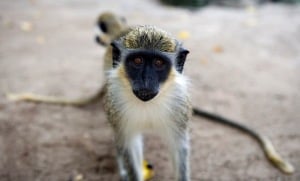 With the holiday season now in full swing, the unseasonable warmth leading up to Christmas 2014 got me thinking about what really make Christmas Christmas? For me the season just wouldn’t be complete without terrible television re-runs, twinkling Christmas lights, indulgent hot chocolate and a curious robin hopping expectantly round the garden as you bed it down for winter. Yes, as far back as I can remember these canny little birds have been as much a part of Christmas as the tree or the turkey. But, how much do we really know about our festive feathered friends and just how did they become such a mainstay of the holiday season? So as a late Christmas present, here is a collection of robin facts to get you a bit better acquainted with our friendly robin redbreast (Erithacus rubecula):
With the holiday season now in full swing, the unseasonable warmth leading up to Christmas 2014 got me thinking about what really make Christmas Christmas? For me the season just wouldn’t be complete without terrible television re-runs, twinkling Christmas lights, indulgent hot chocolate and a curious robin hopping expectantly round the garden as you bed it down for winter. Yes, as far back as I can remember these canny little birds have been as much a part of Christmas as the tree or the turkey. But, how much do we really know about our festive feathered friends and just how did they become such a mainstay of the holiday season? So as a late Christmas present, here is a collection of robin facts to get you a bit better acquainted with our friendly robin redbreast (Erithacus rubecula):
A red breasted mail carrier: Robins, with their bright red breasts, curious nature and friendly disposition have earned themselves the title of UK’s favourite bird. But, as a year round mainstay of the British garden, how did these birds also become one of the most iconic symbols of Christmas.
 It is thought that the robin leant it’s name to mail carriers or postmen of the early to mid1800s. During this period postmen wore a distinctive scarlet uniform, earning them the nickname ‘redbreasts’. Around Christmas the ‘redbreast’ army was strong on the ground, spreading festive cheer and mailing our seasonal greetings; and, it wasn’t long before the postmen’s namesake the robin started making an appearance on the cards they were delivering (often depicted with letters in their beaks). This and the robins regular presence in the winter garden, has earned them a role in festive history.
It is thought that the robin leant it’s name to mail carriers or postmen of the early to mid1800s. During this period postmen wore a distinctive scarlet uniform, earning them the nickname ‘redbreasts’. Around Christmas the ‘redbreast’ army was strong on the ground, spreading festive cheer and mailing our seasonal greetings; and, it wasn’t long before the postmen’s namesake the robin started making an appearance on the cards they were delivering (often depicted with letters in their beaks). This and the robins regular presence in the winter garden, has earned them a role in festive history.
Night singing: It seems that not only has the humble robin had a significant effect on our lives, but, in turn, we are also affecting theirs. Researchers have recently discovered that many urban birds, including the robin, have taken to singing at night – a pretty unusual behaviour for these diurnal creatures. But, what could cause these unusual nocturnal outbursts?
Two main theories predominate the scientific literature. The first theory being that artificial lights in major human settlements confuse the birds into mistaking night for day, messing up their circadian clock and leading to this noisy nighttime behaviour. While a second theory proposes that this ‘night singing’ is actually a coping strategy used by birds in response to their noisy urban homes – to ensure they sing at times when they are guaranteed to be heard above the din of the city. Indeed, a study carried out in Sheffield found that robins nesting in louder areas of the city were more likely to sing at night than their more rural cousins. Although the jury is still out on which theory will win, one thing which seems certain is that robins are adapting to life alongside us.
Territory and aggression: One fact few people know about our friend robin redbreast  is that in reality this feisty little fellow is far from the picture of peace and serenity we see on Christmas cards. Indeed, scientists have found that robins are, in fact, fiercely territorial and have been known to violently attack other robins who stray into their territory – especially in the winter months when food is scarce! Indeed, the birds iconic red breast is not used, as you may suspect, to attract a mate, but is actually war paint. Like a red rag to a bull, the territorial robin has been known to attack anything red and feathery which happens to appear in its territory.
is that in reality this feisty little fellow is far from the picture of peace and serenity we see on Christmas cards. Indeed, scientists have found that robins are, in fact, fiercely territorial and have been known to violently attack other robins who stray into their territory – especially in the winter months when food is scarce! Indeed, the birds iconic red breast is not used, as you may suspect, to attract a mate, but is actually war paint. Like a red rag to a bull, the territorial robin has been known to attack anything red and feathery which happens to appear in its territory.
However, there are exceptions to this rule. This year I have been watching a pair of robins foraging in my garden and it appears that these birds are pretty comfortable with each others company. Perhaps it’s the relative abundance of food left over by the mild winter which has sparked the social flame between my birds. However it is also possible that these birds are a pair. Both female and male robins sport the same red breast so, to us, are almost indistinguishable. Pairs of birds have been known to share territory and cooperate over the winter months, so perhaps I have a festive love story infolding in my garden this winter.
 Human interaction: Although robins don’t always play nicely together, when it comes to their interactions with us they certainly know which side their bread is buttered. Anyone who has turned over soil in their garden is likely to have noticed these worm-loving birds hovering close by, waiting to collect the wriggly spoils of the newly turned soil. Some patient individuals have even been able to exploit the trusting and curious nature of robins, ultimately encouraging birds to eat directly out of their hands – something I’d certainly like to try.
Human interaction: Although robins don’t always play nicely together, when it comes to their interactions with us they certainly know which side their bread is buttered. Anyone who has turned over soil in their garden is likely to have noticed these worm-loving birds hovering close by, waiting to collect the wriggly spoils of the newly turned soil. Some patient individuals have even been able to exploit the trusting and curious nature of robins, ultimately encouraging birds to eat directly out of their hands – something I’d certainly like to try.
So now we know a little bit more about our feathered Christmas companions and hopefully have a better understanding of this enigmatic and iconic garden visitor.
Post by: Sarah fox.















